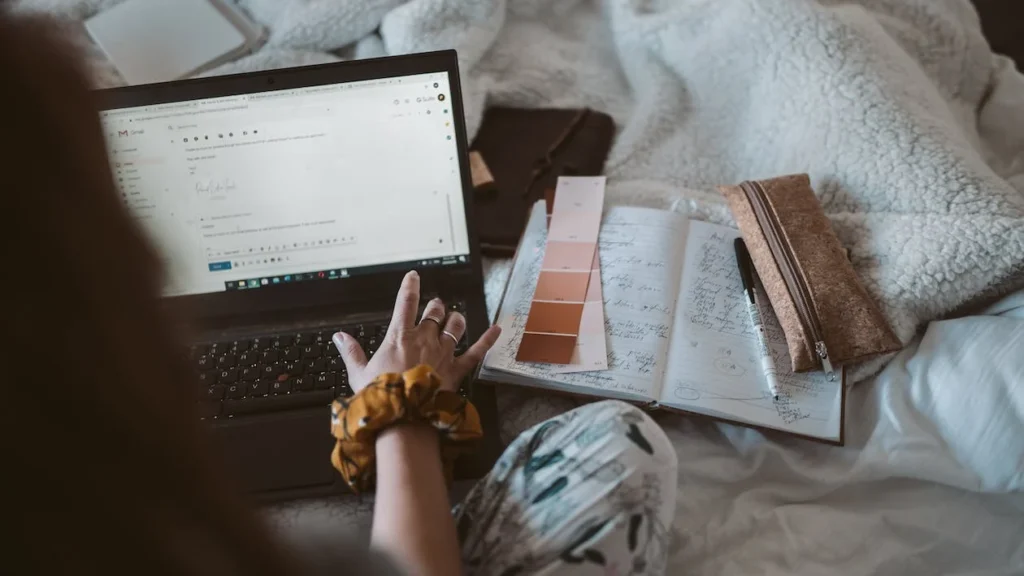Success Metrics for Fashion Marketing
Fashion brands on the hunt for bigger sales and brand recognition need to get their heads around success metrics. With clear goals at the ready and specific indicators to match, these brands can figure out if their marketing moves are hitting the right notes.
Key Performance Indicators (KPIs) Importance
Key Performance Indicators (KPIs) are the bread and butter for checking how fashion marketing plans pan out. They give a concrete look at all the ups and downs in brand performance:
| KPI | Description |
|---|---|
| Website Traffic | A headcount of visitors stopping by the website, showing how much buzz and reach the brand’s getting. |
| Engagement Rates | The back-and-forth between folks and digital content, mirroring customer intrigue. |
| Social Media Mentions | How often the brand’s name pops up, reflecting its popularity and action on social platforms. |
| Conversion Rates | The slice of visitors finally clicking ‘buy’, showing how well sales tactics hit home. |
| Revenue Generated | Total bucks raked in from a campaign, the big picture of success. |
Keeping an eye on these stats lets fashion brands set sharp goals and track how they’re moving along their planned path (Good Kids). This clear focus allows marketers to tweak their game plan, zooming in on actions that really pay off.
Analyzing Campaign Effectiveness
Brands need to know if they’re on the right track. Analyzing how effective a campaign is helps zero in on strategies that get the crowd buzzing and buying. Success metrics like website hits, social media chatter, and sales numbers shed light on a brand’s mojo (Good Kids).
Building a strong analysis routine with regular check-ins will guide brands on sprucing up future marketing gigs. Going with a data-driven route sharpens decision-making and keeps resources spent wisely. Here are some effective ways to flex marketing muscles in fashion:
- Keeping the brand vibe consistent
- Investing in killer visuals
- Chatting it up with customers
- Smartly playing the influencer card
- Letting user reviews sing praises
For those itching to see more on hitting it big in fashion marketing, our articles on fashion marketing strategies and SEO for fashion websites are worth a peek.
By keeping tabs on these telling numbers and shaking things up as needed, fashion brands can keep sharp and ready in the cutthroat market.
Insights from Target Audience Preferences
Getting a handle on what clicks with your audience is the secret sauce of fashion marketing. By crunching numbers from old campaigns and getting cozy with tech, brands can whip up marketing strategies that really speak to their people.
Understanding the Data for Campaigns
Brands need to dig into the data to know what makes their customers tick. Stuff like how many folks visit a website, how they’re interacting on social media, and how many actually buy something lets you see if your plans are hitting the mark or missing the boat (Good Kids).
Take a hard look at where your effort and cash are going by checking out the different marketing avenues. Here’s a peek at some important metrics used to size up campaigns:
| Metric | What’s It About | Why Does It Matter? |
|---|---|---|
| Website Traffic | Visitors hitting the site | Shows who’s peeping at your stuff |
| Social Media Engagement | Likes, shares, comments | Judges how well content’s playing out |
| Sales Conversions | Folks who buy after visiting | Rates campaign’s sales push |
By pulling from these insights, fashion brands can step up their game to better match what their audience digs, ramping up both how engaged folks get and the bottom line.
Making Marketing Personal
Personal touches are what’s driving today’s fashion marketing. Knowing the different personas out there—like the Fashion-Forward Thinker, the Trendy Aspirer, and the Eco-Minded Shopper—means brands can send messages that hit home. Tuning into what these folks value makes the campaign more impactful (Oban International).
Making it personal is easier than you might think with these tactics:
- Use analytics and AI to tailor content that feels custom-made
- Use social media as a hands-on chat line with customers
- Mix in user-submitted content and influencers to sprinkle in trust and realness
Look at Sephora—they’ve nailed it, merging social media with their shopping sites. That move not only makes access a breeze but also boosts sales with tips, customer shares, and influencer tie-ins (Forbes). Check out our piece on fashion marketing strategies for more nuggets.
Understanding what resonates with your crowd by mining data and personalizing marketing approaches puts fashion brands in a prime spot to scoop up more engagement and sales. This hustle beefs up brand presence and profiles in this cutthroat fashion scene.
Optimizing Marketing Budgets
In the dog-eat-dog world of fashion marketing, stretching those dollars is key to staying on top. It’s all about getting your money’s worth and putting cash where it’ll do the most good.
Maximizing Return on Investment (ROI)
ROI, or Return on Investment, is like the report card for brands’ marketing dollars. It’s a simple way to see if those campaigns are passing with flying colors or flunking out. Basically, it’s how brands know if their efforts are worth the dough. To figure it out, just take the revenue brought in by a campaign, subtract the campaign cost, then divide by the cost. Have a look:
| Campaign Cost | Revenue Made | ROI Math | ROI Percentage |
|---|---|---|---|
| $1,000 | $5,000 | (5,000 – 1,000) / 1,000 | 400% |
| $2,000 | $6,000 | (6,000 – 2,000) / 2,000 | 200% |
| $500 | $1,500 | (1,500 – 500) / 500 | 200% |
Fashion brands, by checking out which campaigns hit the mark, can better decide where to splash their cash. That way, every dollar works harder and boosts the bottom line. And if you really want the lowdown, checking KPIs like Return On Advertising Spend (ROAS) gives a peek into if ads are worth their weight in gold.
Effective Allocation of Marketing Funds
If brands wanna bang for their buck, they gotta know where to put their money. Invest where it pays off the best, like those platforms and tricks that click with customers. Today’s tech—like social media vibes, crunching numbers, and smart tools—is a lifesaver for figuring out what makes buyers tick (AMW Group).
Metrics like the number of people visiting a store, how many buys something, and the average amount spent can paint a clear picture of marketing success (Digital Fashion Academy). And don’t sleep on influencer marketing — it can really put a brand on the map and get the folks buzzing.
A calculated game plan for tossing marketing bucks around makes sure everything lines up with big-picture goals, fueling brand growth and carving out a sweet spot in the market. Brands can dig into a myriad of fashion marketing strategies matched to what they’re aiming for and who they’re talking to.
Building Brand Equity in Fashion
Nailing that brand vibe is like striking gold for fashion brands. They need to craft an identity that doesn’t just fit the fleeting trends but sticks like glue to people’s hearts (and wallets).
Standing Out in the Industry
Making a mark in fashion means spinning a tale folks can’t resist and cooking up marketing schemes that stand out. Brand equity’s all about being that standout star that’s hard to ignore. Nail a campaign that hits the right notes with the crowd, and they won’t just notice you—they’ll back you all the way. Good Kids says the right kind of marketing puts your brand on top of the heap.
What’s the secret sauce? A killer brand story. This isn’t just about snagging customers; it’s about weaving connections that tug at heartstrings. Shopify explains that fashion storytelling isn’t just spin—it’s about turning buyers into believers who share your brand gospel.
| Strategy | Impact |
|---|---|
| Engaging Storytelling | Sparks emotion, boosts brand warmth |
| Collaborations with Influencers | Instills trust, spurs genuine interaction |
| Brand Differentiation | Carves identity, cultivates loyalty |
Fostering Brand Loyalty
Keeping fans hooked goes hand in hand with equity in fashion. When folks vibe with what a brand stands for, they return the favor with loyalty—meaning they’ll keep coming back for more and start spreading the good word. This cycle ups the ante on customer value, making the brand tougher to beat.
Using influencers isn’t just trendy; it’s a trust-builder. Social media’s teeming with about 18.6% of people who track influencers for tales that feel real. This rapport boosts a brand’s cred, letting it tap into the influencers’ reach and connect authentically with more folks (Shopify).
Setting up savvy fashion marketing strategies that genuinely build loyalty is a game-changer for brand equity. Brands can’t just sit tight—they’ve gotta keep fine-tuning to match what folks want, making sure their digital threads hit the mark for engagement and experience.
Curious for more? Check out what makes or breaks fashion advertising campaigns and take a peek at how to nail fashion brand positioning.
Role of Fashion Communication
In the fashion biz, talking right means everything. It not only beefs up brand identity but also nudges buyers to reach for their wallets, spreading the word far and wide. Let’s peek into how telling a good yarn and partnering up can really juice up fashion communication.
Impact of Storytelling
Tales are the lifeblood of the fashion world, letting brands cozy up to people on a gut level. Telling a story that sticks can turn customers into cheerleaders, making those marketing efforts do cartwheels (Shopify). It’s a double whammy: it breeds loyalty and keeps ad bills in check, ’cause folks prefer brands that vibe with their beliefs and lives.
When it comes to getting people to open their wallets, a gripping story can do wonders. It helps people see themselves in the outfit, which often seals the deal. For brands wanting to ace their storytelling game, weaving tales into fashion advertising campaigns can really up the ante.
| Storytelling Perks in Fashion |
|---|
| Boosts customer love |
| Turns fans into ambassadors |
| Cuts down ad expenses |
| Builds trust and heartstrings |
Collaborations and Visual Elements
Hooking up with the right folks—journalists, photographers, merchandisers—spices up fashion talk and keeps it real.
Visual tales rule the roost because our brains love pictures more than words. Fashion brands should splash out with short and long videos, infographics, and even sprinkle some augmented reality tech magic.
Eye-catching visuals pull folks in and cement brand messages. Social spots like TikTok and Instagram are champs for encouraging peeps to pitch in with their content, making the brand feel more real and trustworthy. Brands like Nike have nailed it, firing up social media to bring their community into the fold and show the power of visuals in stirring up a crowd (Forbes).
| Visuals in Fashion Talk |
|---|
| Snappy video bits |
| Feature-length vids |
| Eye-popping infographics |
| Augmented reality fun |
Bringing stories and teamwork to the table—especially with visuals—gives fashion marketing the muscle to connect with folks, brush up brand looks, and keep the growth wheel spinning in a feisty marketplace. For more savvy tips on fashion marketing, check out our reads on fashion marketing strategies and luxury fashion marketing.
Tapping Into Tech for Fashion Buzz
Tech keeps flipping the script on how fashionistas and brands tango, turning everything from catwalks to cash registers into digital playgrounds. With a click and a swipe, social media, AR, VR, and AI aren’t just big flashy buttons — they’re the real deal for understanding shoppers and serving up what they didn’t even know they wanted.
Social Media and AR/VR: The Game-Changer Duo
Instagram, Facebook, and Twitter are the go-to hangouts where folks spill the tea on what’s hot and what’s not. People aren’t shy when it comes to sharing their fab finds or fails. Mix in some AR and VR magic, and your customers are not just scrolling, but living the experience. Imagine trying on the latest trends without leaving your couch — that’s a shopaholic’s dream come true (AMW Group).
These digital spectacles make shopping a thrill ride, closing the gap between clicking and buying. Brands that dive into AR and VR create a fun and personal shopping trip, ramping up those ‘Add to Cart’ clicks and smiles at the checkout.
| Tech Trick | What’s the Big Deal? |
|---|---|
| Social Media | Drives buzz with real customer stories; snags instant feedback |
| AR/VR | Creates virtual fashion runways; boosts try-on to buy-on rates |
Data Magic and AI Brainpower
Data and AI have turned into fashion’s secret sauce. By peeking into likes, clicks, and buys, brands can become psychic, offering what fans will love next before they even know it. AI’s not just watching patterns; it’s spotting trends, automating cool campaigns, and getting the scoop on what’ll fly off shelves next.
Knowing why and when stuff comes back is just as crucial. Not all shopping avenues are created equal, and knowing where the loopholes are helps polish up both the sales pitch and the product.
| Info Nugget | Why it Matters |
|---|---|
| Shopper Hints | Customizes promos and stock to suit the crowd |
| Trend Spotting | Lets brands be ahead of the hype with the right stock |
| Returns Savvy | Gauges site success and levels up customer satisfaction |
Using tech right means turning fashion feel-good moments into marketing gold while climbing the style ladder. Brands ready to step up can find more gems in fashion marketing strategies to outshine in the style stakes.
Strategies for Effective Marketing Platforms
When talking fashion marketing, getting on the right platforms is like picking the right shoes for your outfit. It’s not just about looking good, but making sure your audience vibes with your brand and sticks around. Two solid moves? Get social media buzzing and team up with influencers.
Social Media Engagement
Social media ain’t just a place for fleeting likes—it’s where fashion brands get up close and personal with their fans. Brands that mix it up on social sites often ignite conversations and see online cart totals soar. Take Sephora, for instance. They’ve linked their social media game with their online store, showcasing tutorials, user stories, and influencer chit-chat, which has pumped life into their sales and fan base.
Bringing in the big bucks isn’t just luck—it’s about dropping content that speaks to folks. Here’s a peek at the social sites and how they can work magic for fashion:
| Platform | What’s It Got? |
|---|---|
| All about eye-candy pics and stories | |
| Building tight-knit groups and pinpoint ads | |
| TikTok | Quick, catchy vids that hit home |
| Visuals that send folks straight to your site | |
| Real-time chats and brand banter |
Fashion labels can boost their online mojo by connecting customers, creating tribes with shared interests, and sparking feelings that turn followers into loyal fans (Forbes).
Influencer Collaborations
Team-ups with influencers are another win in the playbook. These social stars tap into engaged audiences, adding a sense of realness to your brand story. Look at Nike’s game—they nail community vibes with user interactions and encourage fans to share their own tales (Forbes).
Checking out influencer upsides, here’s why they’re killing it in fashion:
| Advantage | The Lowdown |
|---|---|
| Keeping It Real | Influencers spin content that’s real and raw |
| Go Big or Go Home | Brands dip into a large following pool |
| Bang for Your Buck | High engagement without breaking the bank |
| Boosted Street Cred | Trusted voices amp up your brand trust |
Riding the influencer wave means tapping genuine, wallet-friendly content that boosts brand cred and clicks. It adds glow to your brand’s presence and grooms a community that’s loyal to a tee.
Nailing social media and influencer sync-ups helps fashion brands strut with confidence in a fast-moving scene. For more lowdown on hip marketing moves in fashion, check out fashion marketing strategies.
Importance of User-Generated Content
User-generated content (UGC) is a true game-changer in modern marketing, especially in fashion. It’s like having your most stylish friend endorse your brand—the credibility boost is undeniable!
Building Trust with Consumers
Nothing builds trust faster than hearing from real people who’ve used a product. Ninety-three percent of marketers know that consumers believe content from other shoppers more than content brands crank out themselves. Authentic customer stories and reviews are the bread and butter of building brand trust and drawing in those potential customers.
Young people, especially Gen Z and millennials, are heavily swayed by UGC. With 70% of Gen Z and 78% of millennials saying that UGC influences their buying decisions, it’s clear they value what other customers have to say. This crowd is keen on brands that hand over the microphone to their fans for marketing.
Maximizing UGC Impact
To really cash in on UGC, brands need to weave it into their overall fashion content marketing strategy. Here’s how to make UGC your secret weapon:
| Strategy | Explanation |
|---|---|
| Curate Authentic Content | Pick out UGC that matches the brand’s vibe and shows off products in a flattering light. Keeping it real is key to earning trust. |
| Incentivize Contributions | Give a little something back to customers for sharing their content, which fuels a sense of community and keeps the engagement going strong. |
| Utilize Multiple Platforms | Dive into UGC on places like Instagram, Facebook, and forums where people naturally discuss their experiences. |
| Track Key Metrics | Keep an eye on how UGC performs by looking at engagement, conversions, and customer loyalty. |
By focusing on these strategies, brands can forge a tight-knit bond with their audience, prompting ongoing customer advocacy and emerging as trustworthy leaders in the industry. For more tips on how to amp up your marketing, check out our fashion marketing strategies.
It’s crucial that brands handle UGC with respect to legal and ethical guidelines. Getting the green light from original content creators not only shows respect but also forges stronger consumer connections. This thoughtful handling of UGC can ramp up engagement and loyalty, ultimately boosting sales and brand visibility in the fashion scene.




















